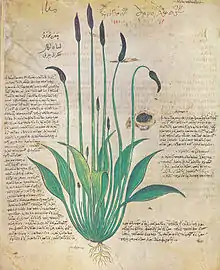.jpg.webp)

Crateuas[4] (111–64 BC),[5] also known as Cratevas[6] (Latin), Krateuas,[7] or Kratevas[5] (Greek: Κρατεύας),[8] was a Greek doctor and pharmacologist. He was distinguished from others of the same name by the epithet "Rootpicker" or "Rhizotomist" (ὁ ῥιζοτόμος, ho rhizotómos) after the Greek name of his principle work, the Herbology.
Life
Little is known of Crateuas's life. Although he is often closely linked with Mithridates VI of Pontus in various histories,[10] surviving sources from antiquity only attest that they were in correspondence with one another[5][11] and that Crateuas credited the Pontic king with the discovery of a plant named mithridation in his honour.[12] The exact plant described remains unknown, although some scholars have connected it to Dorstenia tambourissa or Erythronium denscanis.[13]
Works
Crateuas is known to have written a scholarly three-volume herbal[14] in Greek known as the Rhizotomica[15] (τὰ Ῥιζοτομούμενα, Rhizotomoúmena).[16] In it, he described the medicinal properties of various plants known to the Greeks. He also produced a simplified work on the same subject for general readers, with the plants alphabetized and illustrated in colour.[14] Pliny the Elder credits Crateuas with Dionysius and Metrodorus as the first to provide such illustrations with their descriptions of various plants, although he complains that the images he knew of were frequently misleading.[4] Only two direct fragments of these works are known to have survived into the present day.[14] Luigi Anguillara claimed to have consulted a complete illustrated manuscript of Crateuas's guide in Istanbul for his 1561 Semplici,[17][18] although Max Wellmann subsequently established that Anguillara's source must have been a Latin version of Dioscurides's De Materia Medica.[7]
The Rhizotomica was well regarded in its time,[11] however, and was one of the main sources for Dioscurides's work, which was the primary herbology for Europe during the Middle Ages. The early 6th century "Vienna Dioscurides"[19] produced for Anicia Juliana in Constantinople includes numerous images captioned with short texts beginning with the name Crateuas. Wellmann and Singer believed these were based on now-lost manuscripts of Crateuas dating to the 2nd or 3rd century,[7][20] although others have argued that it may only be the text which derives from Crateuas's work.[21]
Legacy
Linnaeus named a genus of Capparaceae capers Crateva in memory of Crateuas.[22][23]
References
Citations
- ↑ Dioscurides 1907, Cod. Vindobonensis med. gr. 1, fol. 3v.
- ↑ Der Wiener Dioskurides (1998), p. 18.
- ↑ Dioscurides 1907, Cod. Vindobonensis med. gr. 1, fol. 29v.
- 1 2 Pliny, §25.4.
- 1 2 3 Totelin (2004), p. 4.
- ↑ Burgess (1902), p. 118.
- 1 2 3 Wellmann (1897).
- ↑ Dioscurides (1907), Vol. I, §1.1.
- ↑ Lopez (2020), Vol. III, Ch. 5.
- ↑ See, e.g., Lopez's Medicine and Oncology.[9]
- 1 2 Totelin & al. (2016), p. 44.
- ↑ Pliny, §25.26.
- ↑ Burgess (1902), p. 119.
- 1 2 3 Deutsches Museum (2016).
- ↑ Burgess (1902), p. 120.
- ↑ Sprengel (1817).
- ↑ Anguillara (1561).
- ↑ Sprengel (1846), p. 593.
- ↑ Dioscurides 1907, Cod. Vindobonensis med. gr. 1.
- ↑ Singer (1927).
- ↑ Totelin & al. (2016), p. 118.
- ↑ Linnaeus (1737), p. 92.
- ↑ Linnaeus (1742), p. 231.
Bibliography
- "Die Botanik in der Antike", Website, Munich: Deutsches Museum, 2016, archived from the original on 2016-01-20, retrieved 2022-04-20. (German)
- Der Wiener Dioskurides: Codex Medicus Graecus 1 der Österreichischen Nationalbibliothek, Graz: Akademische Druck- und Verlagsanstalt, 1998, ISBN 3-201-01699-3. (German)
- Anguillara, Luigi (1561), Semplici dell'Eccellente, Venice. (Latin)
- Blunt, Wilfrid Jasper Walter (1994), The Art of Botanical Illustration, Dover, ISBN 0-486-27265-6.
- Burgess, Edward Sandford (1902), "Studies in the History and Variations of Asters" (PDF), Memoirs, vol. 10, Torrey Botanical Society, JSTOR 43392214.
- Dioscorides, Pedanius (1906–1914), Wellmann, Max (ed.), De Materia Medica Libri Quinque, Berlin: Weidmann. (Ancient Greek)
- Lopez, Massimo (2020), Medicine and Oncology, Vol. III: Medieval Medicine, Rome: Gangemi Editore, ISBN 978-88-492-4439-7.
- Plinius Secundus, Gaius (1855), The Natural History, translated by Bostock, John, London: Taylor & Francis.
- Singer, Charles (1927), "The Herbal in the Antiquity", Journal of Hellenic Studies, vol. 47, pp. 1–52.
- Sprengel, Kurt (1817), "Kratevas", Geschichte der Botanik, Altenburg, p. 104. (German)
- Sprengel, Kurt (1846), Geschichte der Medizin im Alterthume, Leipzig, p. 104. (German)
- Totelin, Laurence M.V. (2004), "Mithridates' Antidote: A Pharmacological Ghost", Early Science and Medicine, vol. 9, Leuven: Brill, pp. 1–19, JSTOR 4130095.
- Totelin, Laurence; et al. (2016), Ancient Botany, Abingdon: Routledge.
- Von Linné, Carl (1737), Critica Botanica, Leiden. (Latin)
- Von Linné, Carl (1742), Genera Plantarum, Leiden. (Latin)
- Wellmann, Max (1897), "Krateuas", Abhandlungen der Königlichen Gesellschaft der Wissenschaften zu Göttingen: Philologisch-Historische Klasse, New Series, vol. 2, Berlin: Weidmann. (German)
- Wellmann, Max (1898), "Das Älteste Kräuterbuch der Griechen", Festgabe für Franz Susemihl, Leipzig: Teubner, pp. 1–31. (German)
- Yaniv, Zohara (2005), Handbook of Medicinal Plants, Haworth Press, p. 167, ISBN 1-56022-995-0.